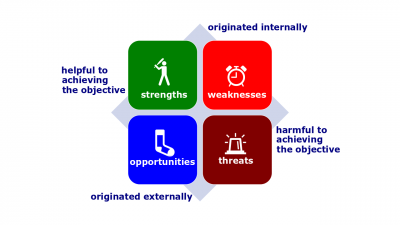Difference between revisions of "SWOT analysis"
| Line 5: | Line 5: | ||
According to [[Management by Robbins and Coulter (14th edition)]], | According to [[Management by Robbins and Coulter (14th edition)]], | ||
:[[SWOT analysis]]. An analysis of the organization's strengths, weaknesses, opportunities, and threats. | :[[SWOT analysis]]. An analysis of the organization's strengths, weaknesses, opportunities, and threats. | ||
| + | According to the [[BABOK Guide|BABOK Guide (3rd edition)]], | ||
| + | :[[SWOT analysis]]. See strengths, weaknesses, opportunities and threats analysis. | ||
==Components== | ==Components== | ||
| Line 15: | Line 17: | ||
*[[Feasibility Study Quarter]]. | *[[Feasibility Study Quarter]]. | ||
| − | [[Category: Management]][[Category: Septem Artes Administrativi]][[Category: Articles]] | + | [[Category: Management]][[Category: Septem Artes Administrativi]][[Category: Articles]][[Category: Business Analysis]] |
Revision as of 09:45, 7 July 2020
SWOT analysis (alternatively known as SWOT framework; hereinafter, the Framework) is a tool that maps analyses of the enterprise environment. SWOT is an acronym for strengths, weaknesses, opportunities, and threats.
Definition
According to Management by Robbins and Coulter (14th edition),
- SWOT analysis. An analysis of the organization's strengths, weaknesses, opportunities, and threats.
According to the BABOK Guide (3rd edition),
- SWOT analysis. See strengths, weaknesses, opportunities and threats analysis.
Components
- Strength. Any activity the organization does well or its unique resource.
- Weakness. An activity the organization does not do well or a resource it needs but does not possess.
- Opportunity. A positive trend in the enterprise environment.
- Threat. A negative trend in the enterprise environment.
